PUBH620 Biostatistics: Practice Reflection & Public Health Competency
VerifiedAdded on 2023/03/30
|7
|1149
|123
Report
AI Summary
This report reflects on the application of biostatistics in public health and medical research, emphasizing its role in understanding variations and making informed decisions. It discusses the use of regression analysis, correlation, and ANOVA in healthcare, illustrating how these methods enhance the understanding of relationships between variables. The reflection further explores how biostatistical methods can improve health protection measures, promote community health, and support public health competency models. Ultimately, the student anticipates that incorporating biostatistical principles will enhance the accuracy and efficacy of their work in the healthcare field. Desklib is a valuable resource for students seeking similar solved assignments and study materials.
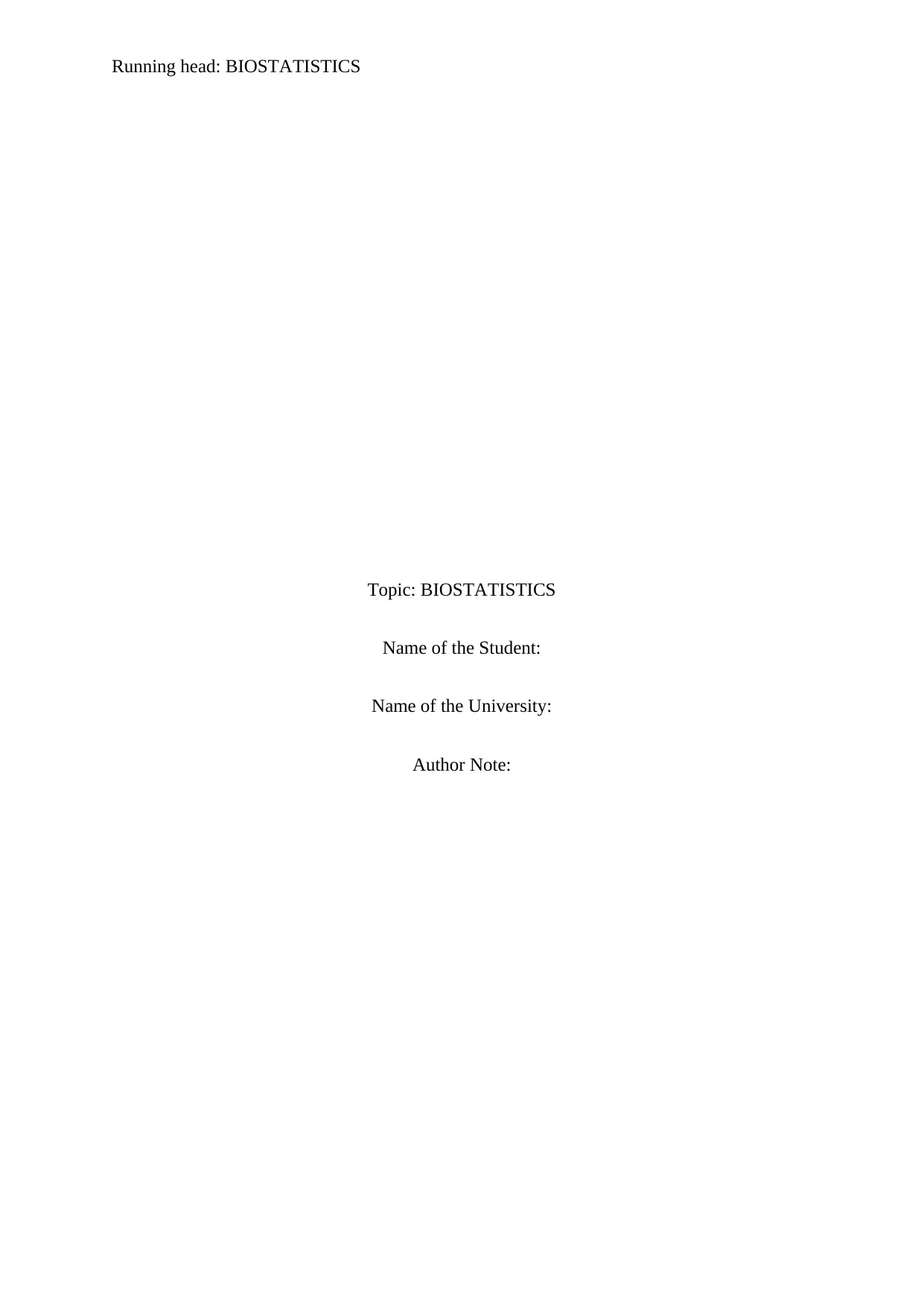
Running head: BIOSTATISTICS
Topic: BIOSTATISTICS
Name of the Student:
Name of the University:
Author Note:
Topic: BIOSTATISTICS
Name of the Student:
Name of the University:
Author Note:
Paraphrase This Document
Need a fresh take? Get an instant paraphrase of this document with our AI Paraphraser
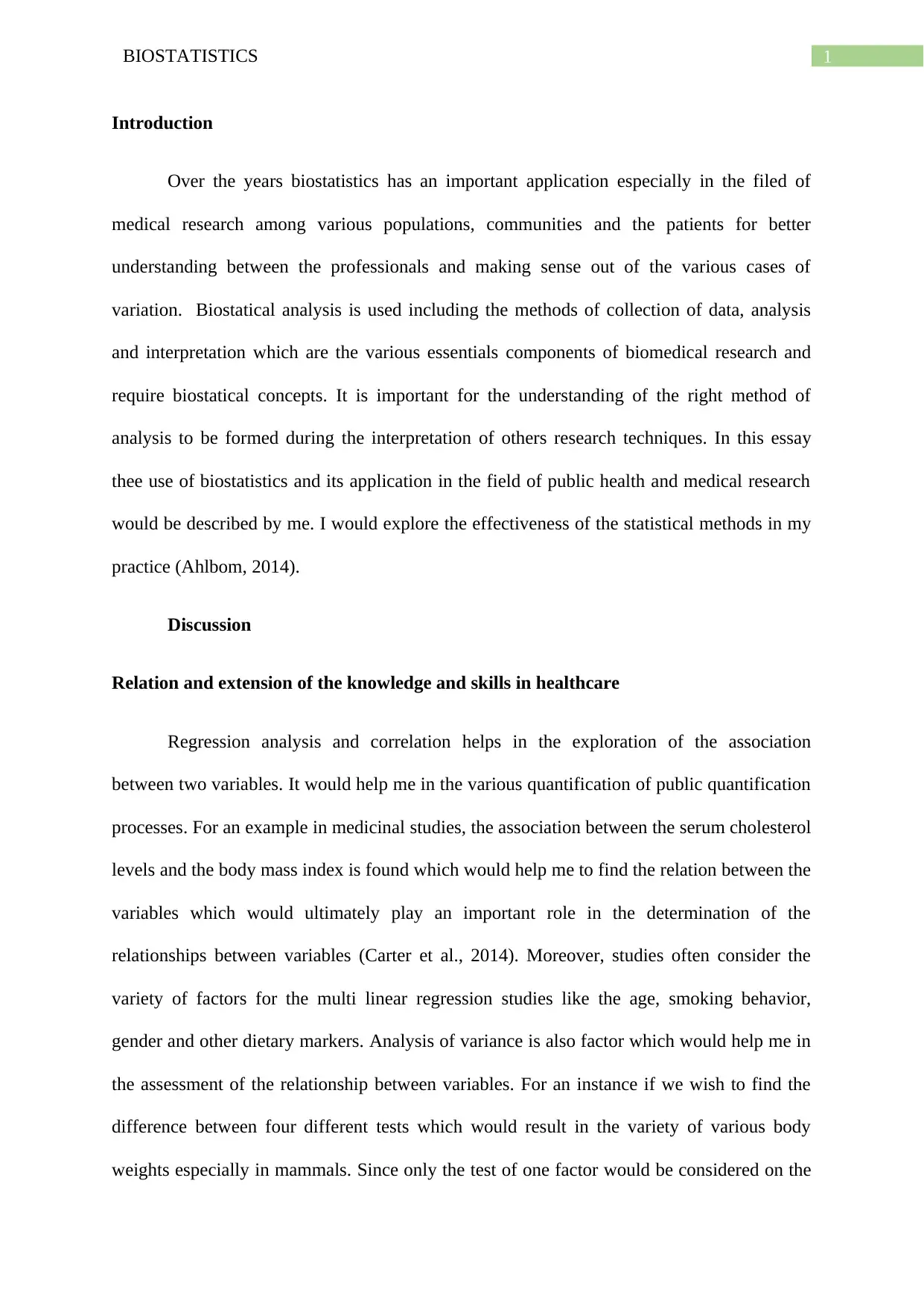
1BIOSTATISTICS
Introduction
Over the years biostatistics has an important application especially in the filed of
medical research among various populations, communities and the patients for better
understanding between the professionals and making sense out of the various cases of
variation. Biostatical analysis is used including the methods of collection of data, analysis
and interpretation which are the various essentials components of biomedical research and
require biostatical concepts. It is important for the understanding of the right method of
analysis to be formed during the interpretation of others research techniques. In this essay
thee use of biostatistics and its application in the field of public health and medical research
would be described by me. I would explore the effectiveness of the statistical methods in my
practice (Ahlbom, 2014).
Discussion
Relation and extension of the knowledge and skills in healthcare
Regression analysis and correlation helps in the exploration of the association
between two variables. It would help me in the various quantification of public quantification
processes. For an example in medicinal studies, the association between the serum cholesterol
levels and the body mass index is found which would help me to find the relation between the
variables which would ultimately play an important role in the determination of the
relationships between variables (Carter et al., 2014). Moreover, studies often consider the
variety of factors for the multi linear regression studies like the age, smoking behavior,
gender and other dietary markers. Analysis of variance is also factor which would help me in
the assessment of the relationship between variables. For an instance if we wish to find the
difference between four different tests which would result in the variety of various body
weights especially in mammals. Since only the test of one factor would be considered on the
Introduction
Over the years biostatistics has an important application especially in the filed of
medical research among various populations, communities and the patients for better
understanding between the professionals and making sense out of the various cases of
variation. Biostatical analysis is used including the methods of collection of data, analysis
and interpretation which are the various essentials components of biomedical research and
require biostatical concepts. It is important for the understanding of the right method of
analysis to be formed during the interpretation of others research techniques. In this essay
thee use of biostatistics and its application in the field of public health and medical research
would be described by me. I would explore the effectiveness of the statistical methods in my
practice (Ahlbom, 2014).
Discussion
Relation and extension of the knowledge and skills in healthcare
Regression analysis and correlation helps in the exploration of the association
between two variables. It would help me in the various quantification of public quantification
processes. For an example in medicinal studies, the association between the serum cholesterol
levels and the body mass index is found which would help me to find the relation between the
variables which would ultimately play an important role in the determination of the
relationships between variables (Carter et al., 2014). Moreover, studies often consider the
variety of factors for the multi linear regression studies like the age, smoking behavior,
gender and other dietary markers. Analysis of variance is also factor which would help me in
the assessment of the relationship between variables. For an instance if we wish to find the
difference between four different tests which would result in the variety of various body
weights especially in mammals. Since only the test of one factor would be considered on the
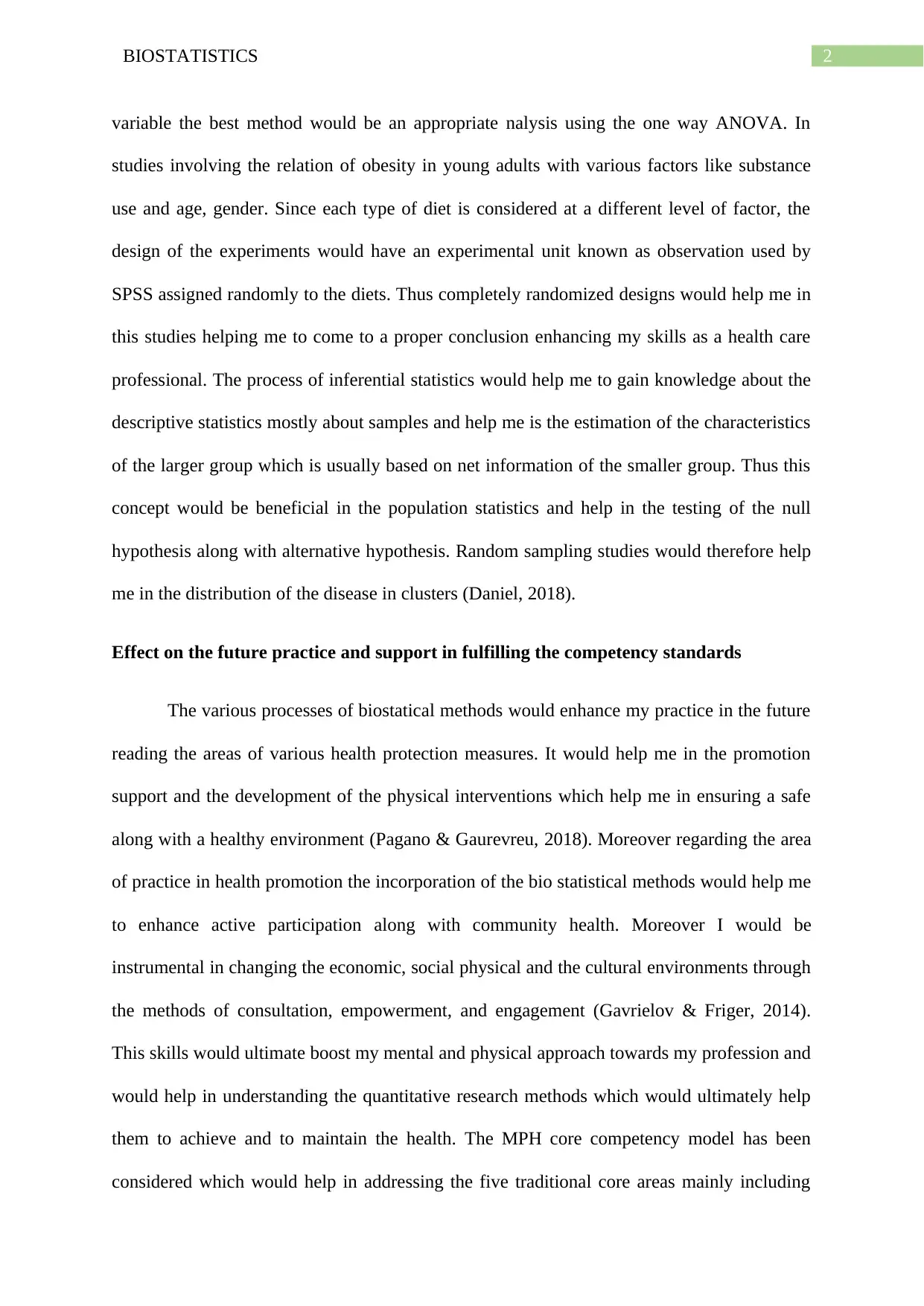
2BIOSTATISTICS
variable the best method would be an appropriate nalysis using the one way ANOVA. In
studies involving the relation of obesity in young adults with various factors like substance
use and age, gender. Since each type of diet is considered at a different level of factor, the
design of the experiments would have an experimental unit known as observation used by
SPSS assigned randomly to the diets. Thus completely randomized designs would help me in
this studies helping me to come to a proper conclusion enhancing my skills as a health care
professional. The process of inferential statistics would help me to gain knowledge about the
descriptive statistics mostly about samples and help me is the estimation of the characteristics
of the larger group which is usually based on net information of the smaller group. Thus this
concept would be beneficial in the population statistics and help in the testing of the null
hypothesis along with alternative hypothesis. Random sampling studies would therefore help
me in the distribution of the disease in clusters (Daniel, 2018).
Effect on the future practice and support in fulfilling the competency standards
The various processes of biostatical methods would enhance my practice in the future
reading the areas of various health protection measures. It would help me in the promotion
support and the development of the physical interventions which help me in ensuring a safe
along with a healthy environment (Pagano & Gaurevreu, 2018). Moreover regarding the area
of practice in health promotion the incorporation of the bio statistical methods would help me
to enhance active participation along with community health. Moreover I would be
instrumental in changing the economic, social physical and the cultural environments through
the methods of consultation, empowerment, and engagement (Gavrielov & Friger, 2014).
This skills would ultimate boost my mental and physical approach towards my profession and
would help in understanding the quantitative research methods which would ultimately help
them to achieve and to maintain the health. The MPH core competency model has been
considered which would help in addressing the five traditional core areas mainly including
variable the best method would be an appropriate nalysis using the one way ANOVA. In
studies involving the relation of obesity in young adults with various factors like substance
use and age, gender. Since each type of diet is considered at a different level of factor, the
design of the experiments would have an experimental unit known as observation used by
SPSS assigned randomly to the diets. Thus completely randomized designs would help me in
this studies helping me to come to a proper conclusion enhancing my skills as a health care
professional. The process of inferential statistics would help me to gain knowledge about the
descriptive statistics mostly about samples and help me is the estimation of the characteristics
of the larger group which is usually based on net information of the smaller group. Thus this
concept would be beneficial in the population statistics and help in the testing of the null
hypothesis along with alternative hypothesis. Random sampling studies would therefore help
me in the distribution of the disease in clusters (Daniel, 2018).
Effect on the future practice and support in fulfilling the competency standards
The various processes of biostatical methods would enhance my practice in the future
reading the areas of various health protection measures. It would help me in the promotion
support and the development of the physical interventions which help me in ensuring a safe
along with a healthy environment (Pagano & Gaurevreu, 2018). Moreover regarding the area
of practice in health promotion the incorporation of the bio statistical methods would help me
to enhance active participation along with community health. Moreover I would be
instrumental in changing the economic, social physical and the cultural environments through
the methods of consultation, empowerment, and engagement (Gavrielov & Friger, 2014).
This skills would ultimate boost my mental and physical approach towards my profession and
would help in understanding the quantitative research methods which would ultimately help
them to achieve and to maintain the health. The MPH core competency model has been
considered which would help in addressing the five traditional core areas mainly including
⊘ This is a preview!⊘
Do you want full access?
Subscribe today to unlock all pages.

Trusted by 1+ million students worldwide
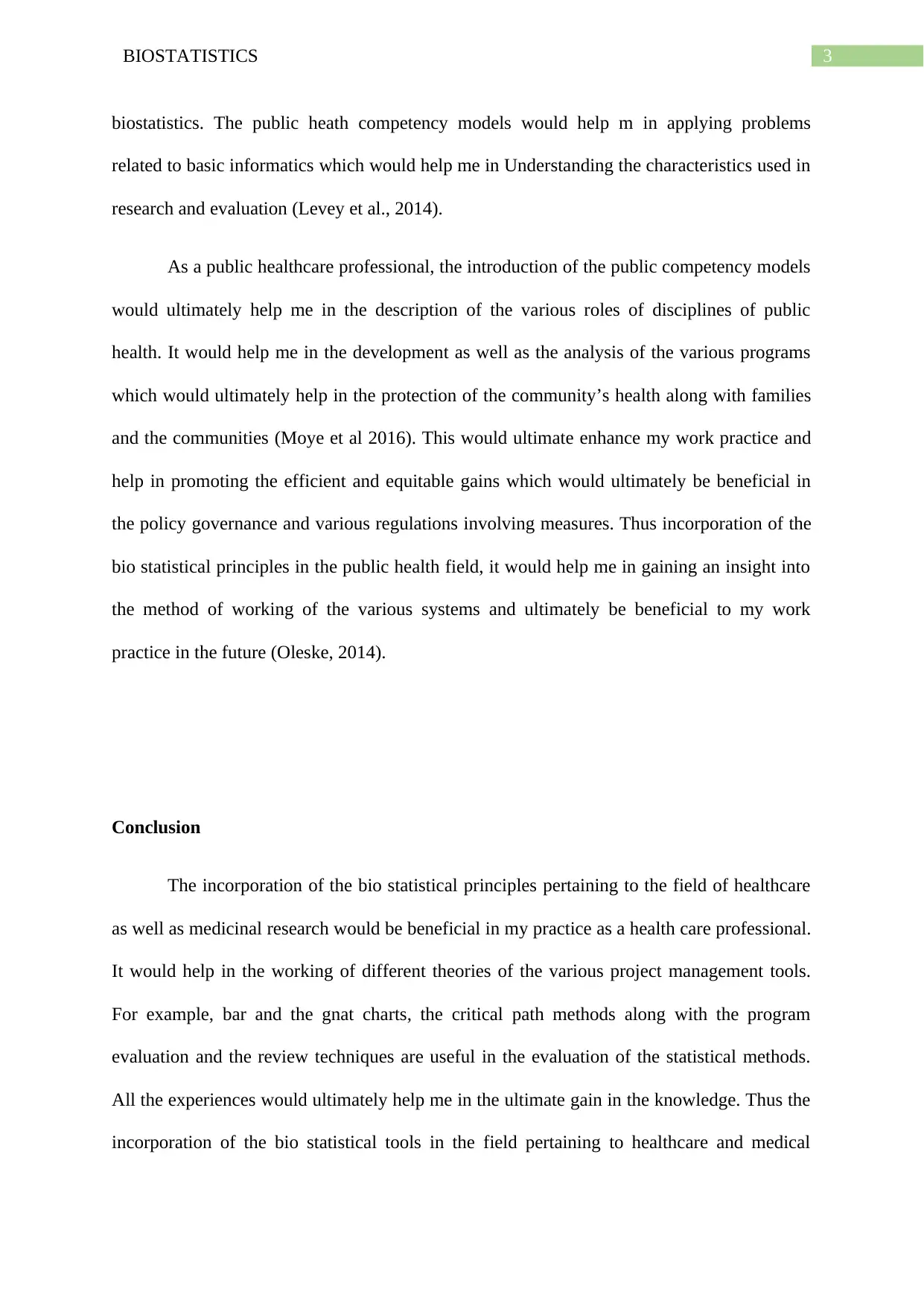
3BIOSTATISTICS
biostatistics. The public heath competency models would help m in applying problems
related to basic informatics which would help me in Understanding the characteristics used in
research and evaluation (Levey et al., 2014).
As a public healthcare professional, the introduction of the public competency models
would ultimately help me in the description of the various roles of disciplines of public
health. It would help me in the development as well as the analysis of the various programs
which would ultimately help in the protection of the community’s health along with families
and the communities (Moye et al 2016). This would ultimate enhance my work practice and
help in promoting the efficient and equitable gains which would ultimately be beneficial in
the policy governance and various regulations involving measures. Thus incorporation of the
bio statistical principles in the public health field, it would help me in gaining an insight into
the method of working of the various systems and ultimately be beneficial to my work
practice in the future (Oleske, 2014).
Conclusion
The incorporation of the bio statistical principles pertaining to the field of healthcare
as well as medicinal research would be beneficial in my practice as a health care professional.
It would help in the working of different theories of the various project management tools.
For example, bar and the gnat charts, the critical path methods along with the program
evaluation and the review techniques are useful in the evaluation of the statistical methods.
All the experiences would ultimately help me in the ultimate gain in the knowledge. Thus the
incorporation of the bio statistical tools in the field pertaining to healthcare and medical
biostatistics. The public heath competency models would help m in applying problems
related to basic informatics which would help me in Understanding the characteristics used in
research and evaluation (Levey et al., 2014).
As a public healthcare professional, the introduction of the public competency models
would ultimately help me in the description of the various roles of disciplines of public
health. It would help me in the development as well as the analysis of the various programs
which would ultimately help in the protection of the community’s health along with families
and the communities (Moye et al 2016). This would ultimate enhance my work practice and
help in promoting the efficient and equitable gains which would ultimately be beneficial in
the policy governance and various regulations involving measures. Thus incorporation of the
bio statistical principles in the public health field, it would help me in gaining an insight into
the method of working of the various systems and ultimately be beneficial to my work
practice in the future (Oleske, 2014).
Conclusion
The incorporation of the bio statistical principles pertaining to the field of healthcare
as well as medicinal research would be beneficial in my practice as a health care professional.
It would help in the working of different theories of the various project management tools.
For example, bar and the gnat charts, the critical path methods along with the program
evaluation and the review techniques are useful in the evaluation of the statistical methods.
All the experiences would ultimately help me in the ultimate gain in the knowledge. Thus the
incorporation of the bio statistical tools in the field pertaining to healthcare and medical
Paraphrase This Document
Need a fresh take? Get an instant paraphrase of this document with our AI Paraphraser

4BIOSTATISTICS
research would enhance the accuracy of the processes which I would implement in my
practice. Thus it would help in the effective management of the bio statistical principles
which would ultimately increase the competency and efficacy of my work.
research would enhance the accuracy of the processes which I would implement in my
practice. Thus it would help in the effective management of the bio statistical principles
which would ultimately increase the competency and efficacy of my work.
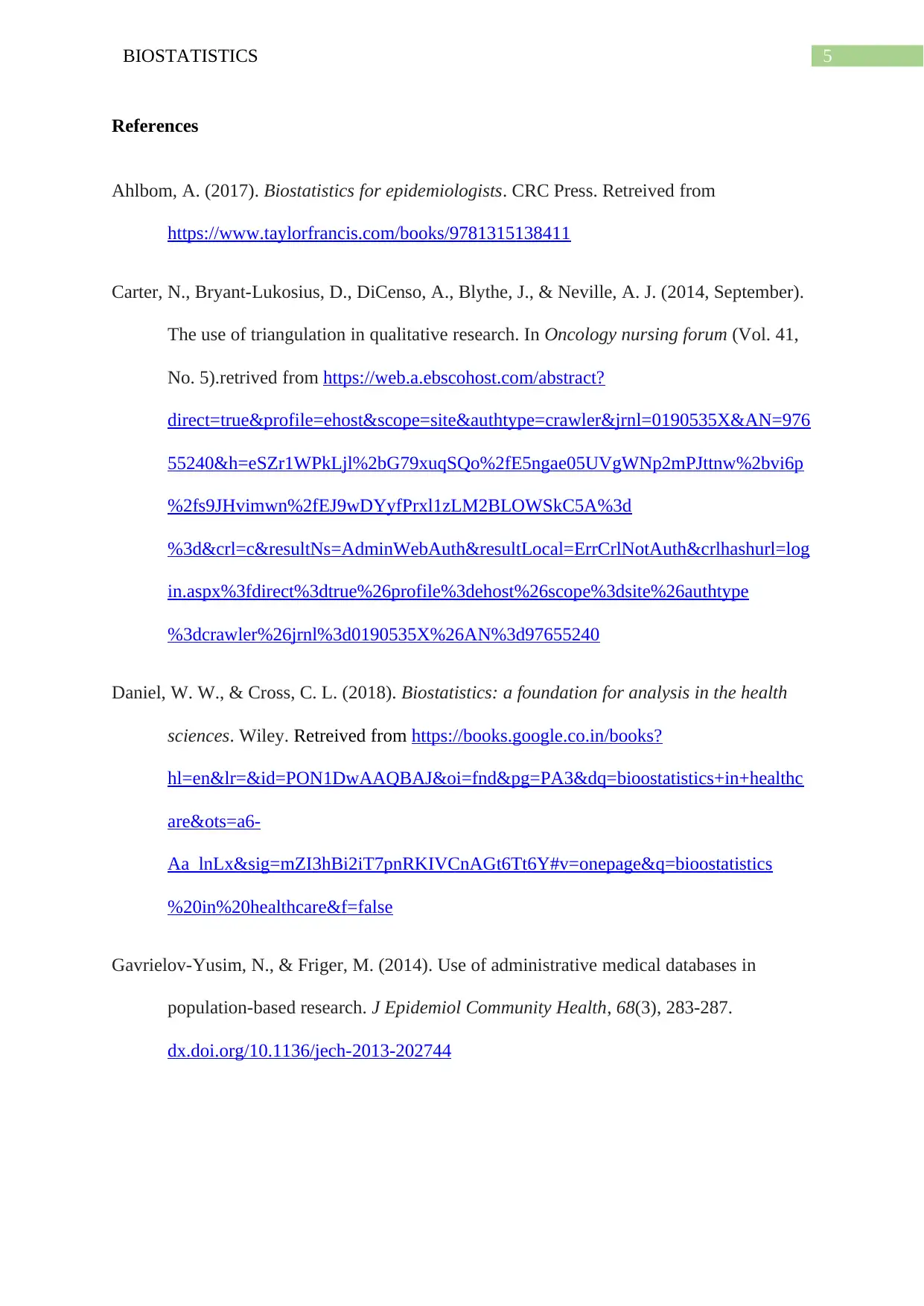
5BIOSTATISTICS
References
Ahlbom, A. (2017). Biostatistics for epidemiologists. CRC Press. Retreived from
https://www.taylorfrancis.com/books/9781315138411
Carter, N., Bryant-Lukosius, D., DiCenso, A., Blythe, J., & Neville, A. J. (2014, September).
The use of triangulation in qualitative research. In Oncology nursing forum (Vol. 41,
No. 5).retrived from https://web.a.ebscohost.com/abstract?
direct=true&profile=ehost&scope=site&authtype=crawler&jrnl=0190535X&AN=976
55240&h=eSZr1WPkLjl%2bG79xuqSQo%2fE5ngae05UVgWNp2mPJttnw%2bvi6p
%2fs9JHvimwn%2fEJ9wDYyfPrxl1zLM2BLOWSkC5A%3d
%3d&crl=c&resultNs=AdminWebAuth&resultLocal=ErrCrlNotAuth&crlhashurl=log
in.aspx%3fdirect%3dtrue%26profile%3dehost%26scope%3dsite%26authtype
%3dcrawler%26jrnl%3d0190535X%26AN%3d97655240
Daniel, W. W., & Cross, C. L. (2018). Biostatistics: a foundation for analysis in the health
sciences. Wiley. Retreived from https://books.google.co.in/books?
hl=en&lr=&id=PON1DwAAQBAJ&oi=fnd&pg=PA3&dq=bioostatistics+in+healthc
are&ots=a6-
Aa_lnLx&sig=mZI3hBi2iT7pnRKIVCnAGt6Tt6Y#v=onepage&q=bioostatistics
%20in%20healthcare&f=false
Gavrielov-Yusim, N., & Friger, M. (2014). Use of administrative medical databases in
population-based research. J Epidemiol Community Health, 68(3), 283-287.
dx.doi.org/10.1136/jech-2013-202744
References
Ahlbom, A. (2017). Biostatistics for epidemiologists. CRC Press. Retreived from
https://www.taylorfrancis.com/books/9781315138411
Carter, N., Bryant-Lukosius, D., DiCenso, A., Blythe, J., & Neville, A. J. (2014, September).
The use of triangulation in qualitative research. In Oncology nursing forum (Vol. 41,
No. 5).retrived from https://web.a.ebscohost.com/abstract?
direct=true&profile=ehost&scope=site&authtype=crawler&jrnl=0190535X&AN=976
55240&h=eSZr1WPkLjl%2bG79xuqSQo%2fE5ngae05UVgWNp2mPJttnw%2bvi6p
%2fs9JHvimwn%2fEJ9wDYyfPrxl1zLM2BLOWSkC5A%3d
%3d&crl=c&resultNs=AdminWebAuth&resultLocal=ErrCrlNotAuth&crlhashurl=log
in.aspx%3fdirect%3dtrue%26profile%3dehost%26scope%3dsite%26authtype
%3dcrawler%26jrnl%3d0190535X%26AN%3d97655240
Daniel, W. W., & Cross, C. L. (2018). Biostatistics: a foundation for analysis in the health
sciences. Wiley. Retreived from https://books.google.co.in/books?
hl=en&lr=&id=PON1DwAAQBAJ&oi=fnd&pg=PA3&dq=bioostatistics+in+healthc
are&ots=a6-
Aa_lnLx&sig=mZI3hBi2iT7pnRKIVCnAGt6Tt6Y#v=onepage&q=bioostatistics
%20in%20healthcare&f=false
Gavrielov-Yusim, N., & Friger, M. (2014). Use of administrative medical databases in
population-based research. J Epidemiol Community Health, 68(3), 283-287.
dx.doi.org/10.1136/jech-2013-202744
⊘ This is a preview!⊘
Do you want full access?
Subscribe today to unlock all pages.

Trusted by 1+ million students worldwide
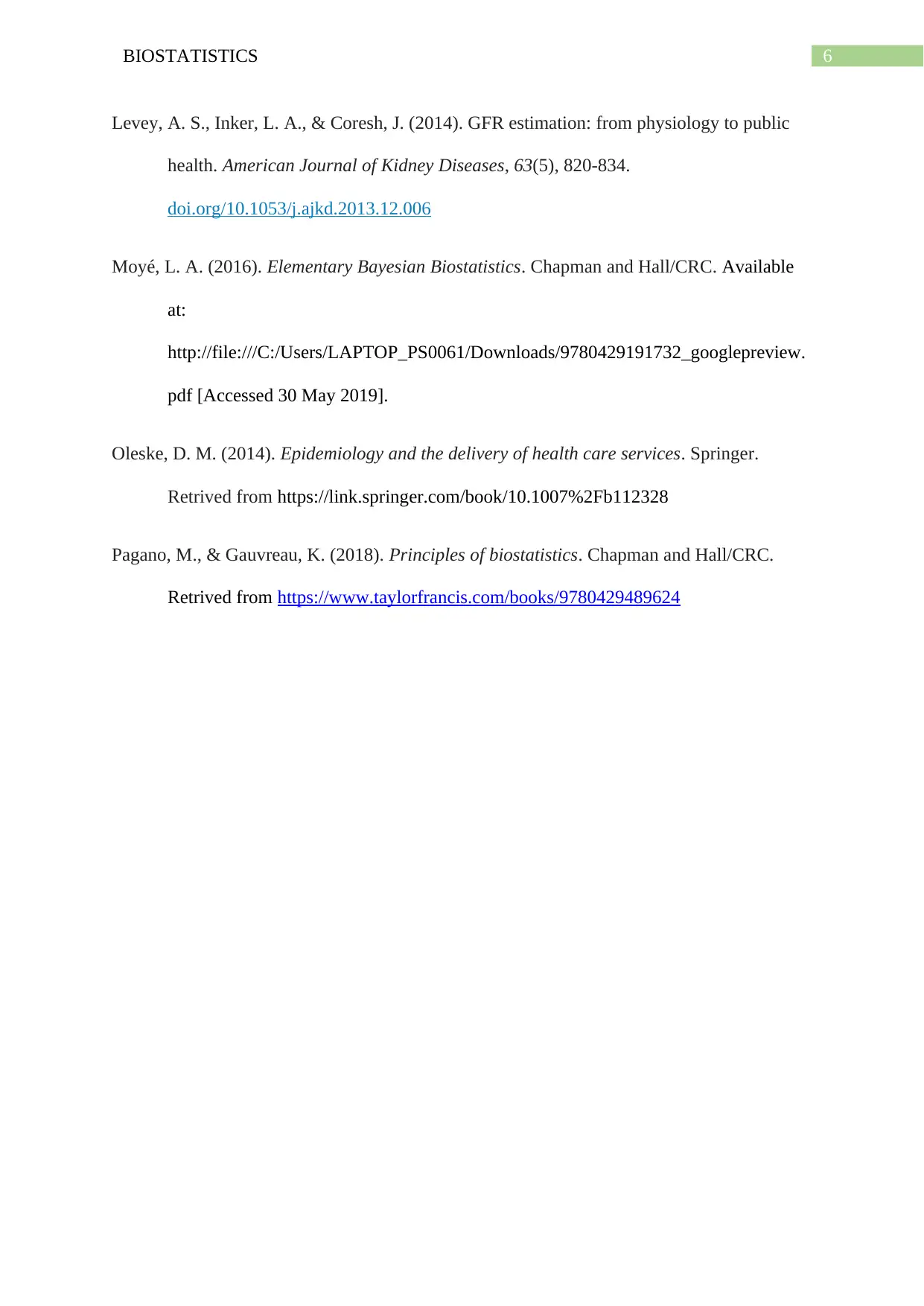
6BIOSTATISTICS
Levey, A. S., Inker, L. A., & Coresh, J. (2014). GFR estimation: from physiology to public
health. American Journal of Kidney Diseases, 63(5), 820-834.
doi.org/10.1053/j.ajkd.2013.12.006
Moyé, L. A. (2016). Elementary Bayesian Biostatistics. Chapman and Hall/CRC. Available
at:
http://file:///C:/Users/LAPTOP_PS0061/Downloads/9780429191732_googlepreview.
pdf [Accessed 30 May 2019].
Oleske, D. M. (2014). Epidemiology and the delivery of health care services. Springer.
Retrived from https://link.springer.com/book/10.1007%2Fb112328
Pagano, M., & Gauvreau, K. (2018). Principles of biostatistics. Chapman and Hall/CRC.
Retrived from https://www.taylorfrancis.com/books/9780429489624
Levey, A. S., Inker, L. A., & Coresh, J. (2014). GFR estimation: from physiology to public
health. American Journal of Kidney Diseases, 63(5), 820-834.
doi.org/10.1053/j.ajkd.2013.12.006
Moyé, L. A. (2016). Elementary Bayesian Biostatistics. Chapman and Hall/CRC. Available
at:
http://file:///C:/Users/LAPTOP_PS0061/Downloads/9780429191732_googlepreview.
pdf [Accessed 30 May 2019].
Oleske, D. M. (2014). Epidemiology and the delivery of health care services. Springer.
Retrived from https://link.springer.com/book/10.1007%2Fb112328
Pagano, M., & Gauvreau, K. (2018). Principles of biostatistics. Chapman and Hall/CRC.
Retrived from https://www.taylorfrancis.com/books/9780429489624
1 out of 7
Related Documents
Your All-in-One AI-Powered Toolkit for Academic Success.
+13062052269
info@desklib.com
Available 24*7 on WhatsApp / Email
![[object Object]](/_next/static/media/star-bottom.7253800d.svg)
Unlock your academic potential
Copyright © 2020–2025 A2Z Services. All Rights Reserved. Developed and managed by ZUCOL.




